Every seasoned traveler knows that a successful trip depends on accurate information. Flight departure times, route info, hotel reservation numbers – all of it can make or break the best planned trip. Having good sources of information during the trip is critical.
Some readers will recall that during an earlier trip I questioned the quality of information provided by airport shuttle bus drivers. But I had no doubts about the veracity of Ottavia, our guide for the Roman Food Tour we took on our second day in Rome. (Truth: We had to trust her if we wanted dinner.). She led a dozen hungry and thirsty travelers around the Prati neighborhood in Rome for four hours on Saturday evening.
Ottavia established her credibility quickly by memorizing all our names and our hometowns just from doing brief introductions when we met at the Cipro Metro station, just behind the high walls of Vatican City.
“Prati” means “field” in Italian. That was one of the first things she told us during a pre-tour huddle. The neighborhood we were exploring had once been part of the fields that surrounded the Vatican. Today the neighborhood has a split personality – “old Prati” and “new Prati”, based on the architectural style of the buildings. The area is populated by artists and lawyers, though I don’t recall if she mentioned that those demographic groups were also segregated.
Over the course of the evening, we visited four restaurants, a specialty food shop and a gelateria. Each of the restaurants provided a sample of their fare. All but one paired the food with a good Italian wine.
Throughout the evening, Ottavia kept up a running commentary about the individual food items, including details about where they came from and how they were prepared. She taught us about the government certifications – D.O.C. and D.O.C.G. for wine and D.O.P. for food. Some of what she said passed in one ear and out the other, especially during the later courses, when we’d had several glasses of wine. But despite the limits of our comprehension, it was a delightful evening with a small group of like-minded travelers. Our group included a man from Las Vegas who was traveling on business, and vacationing couples from Wichita, Kansas; Calgary, Canada; Sweden; and the District of Columbia.
Here are some of the memorable moments from the tour.
Our first stop was Pizzarium Bonci (Via Della Meloria, 43, http://www.gbonci.it/ ). This is a small, walk-up pizza shop run by Chef Gabriele Bonci, sometimes known as the “Pizza Emperor” of Rome. Chef Bonci uses Marino flour from northern Italy and lets his dough rise for 72 hours to give the crust a crisp bottom and soft top.
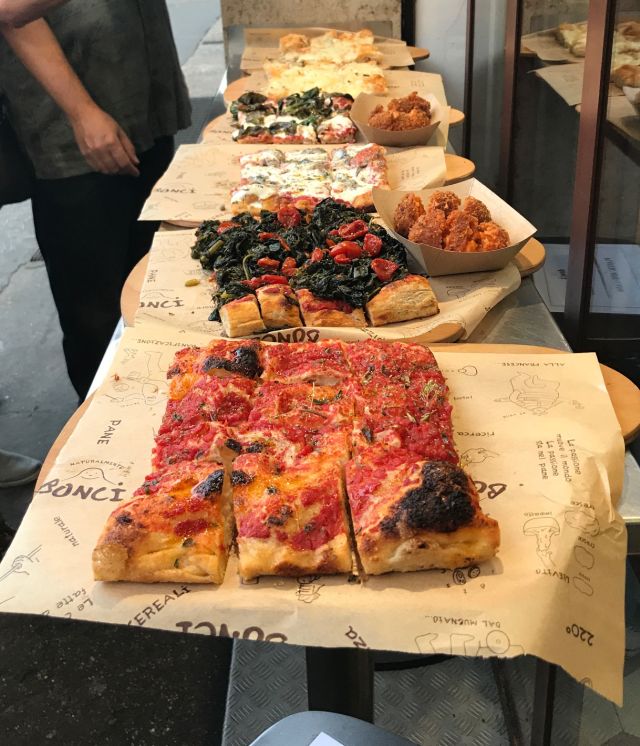
Next we visited La Bufalina – “the Little Buffalo” (Via Marcantonio Bragadin, 99, no web site). This is a small restaurant that seats about 25 people at two long tables. We had a tasting of a variety of cheeses, paired with a white wine.
True to its name, the first taste was buffalo mozzarella cheese. We learned that real buffalo mozzarella is only made in the Campania region to the south. Ottavia told us that buffalo mozzarella is best if eaten within 24 – 48 after it is made. The restaurant has cheese delivered every day.
We had a small bite of crostini with pesto genovese – pesto made with basil from Genoa. Octavia told us that “pesto” means “crushed”, and that just because you order pesto, doesn’t guarantee that it will be made with basil.
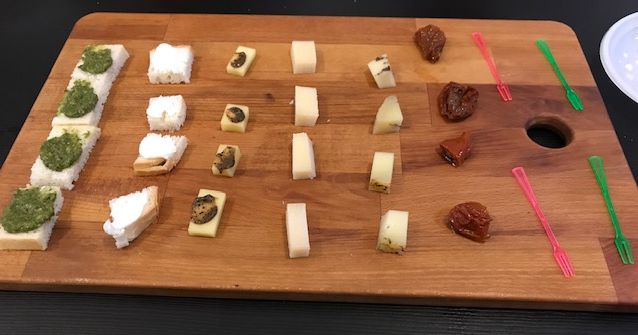
Next we got a lesson on balsamic vinegar. There are two kinds – “table balsamic” and “aged balsamic” Both originate in the town of Modena.
Table balsamic (also known as “white label”) is made from white grapes, with coloring added. It is made and shipped quickly.
Aged balsamic is made with both white and red grapes and needs no added color. It is aged for a minimum of twelve years and a maximum of thirty years. It is sold in small bottles, all of a similar shape, containing just a few ounces. The producer’s name is never shown on the label. Thirty year old balsamic is known as “gold label” and costs about 165 Euros for the small bottle.
Ottavia walked around the table and carefully dispensed a couple drops of gold label balsamic on the next piece of cheese – a bit of aged pecorino. The balsamic was so thick it would hardly come out of the bottle (probably a good thing at that price!).
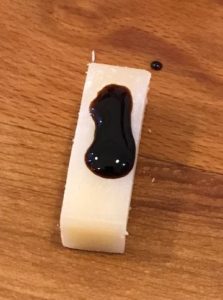
During the aging process, the vinegar loses its acidity, so it becomes so sweet and complex that you just needed a drop. We thought it would be great on strawberries, and hope to try that combination sometime in the future.
We visited La Tradizione (Via Cipro, 8, no web site), a world-famous specialty food and wine shop. There we saw several varieties of prosciutto, some of them costing over 250 euros per kilogram. (That works out to about $7.10 / ounce.) They were not offering any samples.
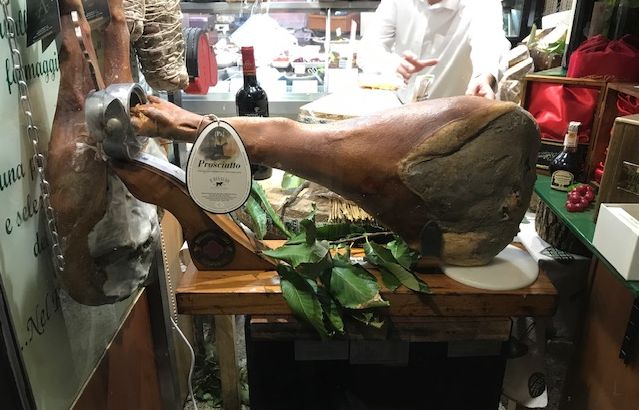
In the front window of the shop was a basket of “tartufo bianco” – white truffles – tagged at EU 3,700 per kg. We do not have sophisticated enough palettes to appreciate the cheaper black truffles, so the white ones will never be in our shopping cart!

Secundo Tradizione (Via Rialto, 39, https://www.secondotradizione.it/) is a restaurant started by the owners of La Tradizione. They served us a selection of four hams and four cheeses.
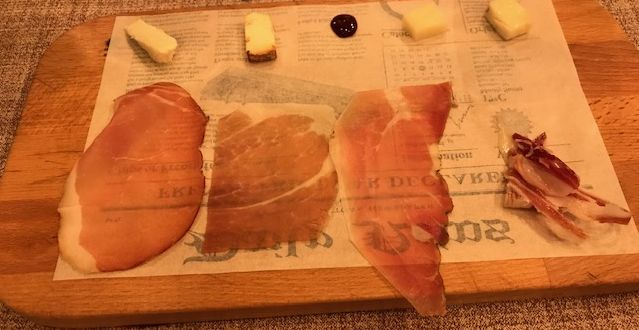
Cheeses (left to right, top row): Robiola Tre Latti (“Three milks” cheese made with sheep, goat and cow’s milk), Torta Montenara, mixed berry jam, Pecorino Romano, Gorgonzola.
Ham (left to right, bottom row): Filetuccio Al Barolo (tenderloin ham aged in wine), cinte sanese (“the belted pig of Siena”, prosciutto de Parma, Jamon Iberico (from Spain)
The filetuccio al barollo is aged for four months, bathed in wine for a month, then aged for ten years. The prosciutto de Parma is the “flagship” prosciutto – the most exported. Parma is also the home of parmesan cheese, and the pigs there are fed a diet that includes whey from the cheese making process. As a result, prosciutto de Parma has a noticeable cheesy flavor and a distinct mouth feel.
The best restaurant name of the night was Al Giardino del Gatto e la Volpe (Via Buccari, 14, https://www.algiardinodelgattoelavolpe.com/en/ ), “The Garden of the Cat and Fox”. This restaurant has been in business for over 50 years. They served us two courses. The first was homemade four cheese gnocchi and a ravioli in tomato sauce. The second course was a small plate of fried calamari – hot and salty.
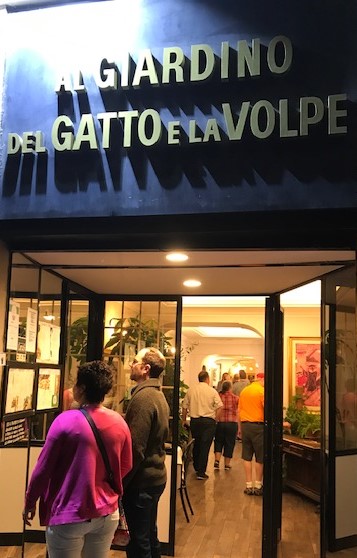
At the last stop of the night, Fatamorgana Gelato (Via Leone IV 50/52, http://www.gelateriafatamorgana.com/web/ ), we learned two things. First, when entering a gelateria, look at how the product is displayed. The best gelato will never be whipped up above the edge of the container.

And second – a lesson that we relearn every time we come to Italy: Any day that ends in “y” will be a better day when you have gelato!
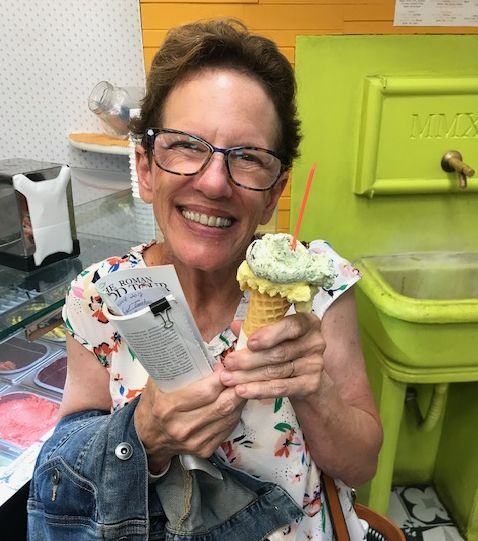
===============================================
What’s the most unusual food you have eaten lately? Leave us a note in the comments below.
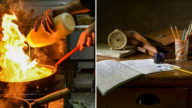
===============================================

Three things:
1) Mary looks adorable.
2) I want a green sink like that one.
3) What do you mean by “whipped up above the edge of the container”?? I can’t quite picture what that would be, and I need to able to detect the good stuff when I’m buying gelato! ?
Hey Carol,
1) Yes, Mary IS adorable. 2) You’ll have to find the green sink on your own. 3) Thanks for the question about gelato. You now how gelato is displayed in big tubs. If the gelato is piled up above the edge of the tubs, Ottavia thought it was questionable. According to her, you want to see the level in the tub below the sides.